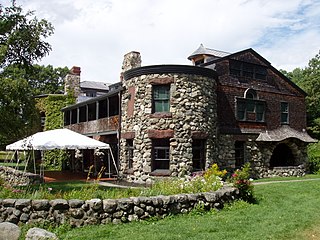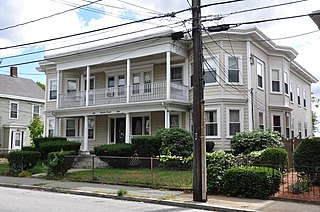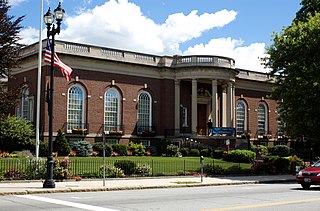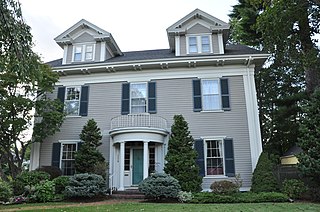
The Metropolitan State Hospital was an American public hospital for the mentally ill, on grounds that extended across parts of Waltham, Lexington, and Belmont, Massachusetts. Founded in 1927, it was at one time the largest and most modern facility of its type in Massachusetts. It was closed in January 1992 as a result of the state's cost-cutting policy of closing its mental hospitals and moving patients into private and community-based settings. The main complex of buildings has subsequently been redeveloped into apartments. The hospital campus was listed on the National Register of Historic Places 1994. The property also housed the Gaebler Children's Center for mentally ill youth.

Gore Place is a historic country house, now a museum, located at 52 Gore Street, Waltham, Massachusetts. It is owned and operated by the nonprofit Gore Place Society. The 45-acre (180,000 m2) estate is open to the public daily without charge; an admission fee is charged for house tours. A number of special events are held throughout the year including an annual sheepshearing festival and a summer concert series.

The Robert Treat Paine Estate, known as Stonehurst, is a country house set on 109 acres (44 ha) in Waltham, Massachusetts. It was designed for philanthropist Robert Treat Paine (1835-1910) in a collaboration between architect Henry Hobson Richardson and landscape architect Frederick Law Olmsted. It is located at 100 Robert Treat Paine Drive. Since 1974 the estate has been owned by the City of Waltham and its grounds kept as a public park, and is believed to be the only residential collaboration by Richardson and Olmsted that is open to the public.

The First Parish Church is a historic church at 50 Church Street in Waltham, Massachusetts, whose Unitarian Universalist congregation has a history dating to c. 1696. The current meeting house was built in 1933 after a fire destroyed the previous building on the same site. It is a Classical Revival structure designed by the nationally known Boston firm of Allen & Collens. The church building was listed on the National Register of Historic Places in 1989.

St. Mary's Roman Catholic Church Complex is a historic multi-building church complex at 133 School Street in Waltham, Massachusetts. Established as a parish in 1835, it is the city's oldest Roman Catholic establishment. Its 1858 Romanesque Revival church and 1872 Second Empire rectory are particularly fine architectural examples of their styles. The complex was listed on the National Register of Historic Places in 1989.

The Charles River Reservation Parkways are parkways that run along either side of the Charles River in eastern Massachusetts. The roads are contained within the Charles River Reservation and the Upper Charles River Reservation, and fall within a number of communities in the greater Boston metropolitan area. The Charles River parks extend from the Charles River Dam, where the Charles empties into Boston Harbor, to Riverdale Park in the West Roxbury neighborhood of Boston. Most of the roadways within the parks are listed on the National Register of Historic Places as a unit, although Storrow Drive and Memorial Drive are listed as part of the Charles River Basin Historic District.

The Aaron Martin Houses are a pair of historic houses in Waltham, Massachusetts. Built between 1892 and 1900, these Colonial Revival houses have similar massing, with hip roofs and double-window hip dormers. Windows on their main facades are treated with pediments incised with floral decoration, and their porches have turned posts. They were built by Aaron Martin, a real estate speculator and Waltham Watch Company employee who lived in a more elaborate house on Moody Street.

The Benjamin Wellington House is a historic house in Waltham, Massachusetts. The 2+1⁄2-story wood-frame house was built c. 1810 by Benjamin Wellington, and is one of the city's few Federal style house with brick end-walls. The house is a well-proportioned five bays wide and three deep, with paired chimneys on each of the gable ends. A single-story porch with Tuscan columns wraps around two sides of the house. The Wellingtons, early settlers of the area, only acquired this farmstead by marriage in the early 19th century.

Mount Feake Cemetery is a historic cemetery at 203 Prospect Street in Waltham, Massachusetts.

The Castle, also known as Usen Castle, is a historic building at 415 South Street in Waltham, Massachusetts. The Medieval style structure, built in 1928 in the style of a Norman castle, stands on the campus of Brandeis University, where it served as a dormitory until 2017. The building, the design of which is unlike any other on the campus or in the city, was listed on the National Register of Historic Places in 1979.

The William Wellington House is a historic house in Waltham, Massachusetts. It was built in 1779 and added to the National Register of Historic Places in 1989. The house stayed in two families until somewhere around 1930 when it was acquired by Middlesex County Hospital. Prior to renovations, it had been abandoned for over 20 years.

The Warren White House is a historic house in Waltham, Massachusetts. The 2+1⁄2-story wood-frame house was built c. 1850–54, and is the oldest surviving house on Warren Street, once an important thoroughfare between Waltham and Belmont. The house has classic Italianate styling, with a symmetrical three-bay facade, wide cornerboards and entablature, and round-arched gable windows. It was built by Warren White, a wheelwright, on land owned by David White, a farmer, who sold Warren White the property in 1855.

The building at 202–204 Charles Street in Waltham, Massachusetts is a well-preserved example of multi-unit residential housing built in the city in the early decades of the 20th century. It was built in 1913, and was listed on the National Register of Historic Places in 1989.

The Waltham Public Library is the public library of the city of Waltham, Massachusetts. Its main location is in the Francis Buttrick Library, an architecturally significant Georgian Revival building built in 1915, funded by a bequest from Francis Buttrick, a major landowner in the city. The building was listed on the National Register of Historic Places in 1989.
Holbrook House or Holbrook Farm may refer to:

The Piety Corner Historic District encompasses one of the oldest settled areas of Waltham, Massachusetts. It is centered on a major road intersection, the junction of Totten Pond Road with Lexington and Bacon Streets, and includes the city's largest single concentration of well-preserved 19th and early 20th-century houses. It extends south from Totten Pond Road along Bacon Street as far as Greenwood Lane, and along Lexington Street to Beaver Street. The district was listed on the National Register of Historic Places in 1990.

The Lawton Place Historic District is a historic district on Lawton Place between Amory Road and Jackson Street in Waltham, Massachusetts. The district preserves some of the nation's oldest textile mill worker housing. The duplex houses located on the south side of Lawton Place were built c. 1815-17 by the Boston Manufacturing Company (BMC), the first mill to process textiles entirely under one roof. They were originally located at what is now the Waltham Common, and were moved to Lawton Place in 1889. On the north side stands a rowhouse that was built in 1889; it is the last instance of a type of row housing that was once commonly built for mill workers. The district was listed on the National Register of Historic Places in 1989.

The Phineas Lawrence House is a historic house at 257 Trapelo Road in Waltham, Massachusetts. The 2+1⁄2-story wood-frame house was built c. 1807-08 by Phineas Lawrence, member of the locally prominent Lawrence family, who had owned land in the northeastern part of Waltham since the 17th century. The house is a well-preserved example of Federal styling. The Lawrence properties were extensive, and included land that was used for the nearby Metropolitan State Hospital.

The Joseph Andrews House is a historic house at 258 Linden Street in Waltham, Massachusetts. Built in 1851, it is one of the city's oldest examples of Italianate architecture, and was one of the first houses built in Linden Street. It was listed on the National Register of Historic Places in 1989.

The Deacon John Holbrook House is a historic building at 80 Linden Street in Brattleboro, Vermont. Built in 1825 for prominent local businessman John Holbrook, it is a high-quality example of Federal period architecture. It was listed on the National Register of Historic Places in 1982. It now houses professional offices.





















